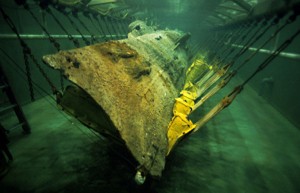The H. L. Hunley, a Confederate submarine named after its inventor, sank under mysterious circumstances in 1864, right after she became the first submarine to sink an enemy ship in combat. After torpedoing the USS Housatonic, a Union warship that was enforcing the blockade of Charleston harbor, the Hunley gave the agreed-upon signal that she was returning to base and then disappeared. No combat submarine would sink a warship for another 50 years.
Her location remained a mystery until underwater archaeologist E. Lee Spence pinpointed the likely location in 1970. It took 25 more years before divers from the National Underwater and Marine Agency would lay hands on her. She was found lying on her starboard side at a 45-degree angle only 100 yards away from the wreck of the Housatonic. The Hunley had been buried in layers of silt which preserved the vessel from treasure hunters and from the elements during her 130 years of slumber.
 Underwater archaeologists took another five years to stabilize the wreck in situ on the ocean floor. Then in 2000, the Hunley was raised. They slipped a series of harnesses underneath her hull attached to a truss, then the recovery barge Karlissa B lifted it with a crane before a cheering crowd in Charleston harbor. The barge took the Hunley to the Warren Lasch Conservation Center in Charleston where, still in her harnesses, she was immersed in a tank of refrigerated fresh water for further conservation.
Underwater archaeologists took another five years to stabilize the wreck in situ on the ocean floor. Then in 2000, the Hunley was raised. They slipped a series of harnesses underneath her hull attached to a truss, then the recovery barge Karlissa B lifted it with a crane before a cheering crowd in Charleston harbor. The barge took the Hunley to the Warren Lasch Conservation Center in Charleston where, still in her harnesses, she was immersed in a tank of refrigerated fresh water for further conservation.
Fast forward 11 years and now scientists are finally ready to take the Hunley out of the cradle and stand her upright. It’s taken so long because, among other tasks, archaeologists have had to map every shell, pebble, and mussel in the concretion layer coating the vessel. Not only does this layer contain valuable information about the Hunley‘s long underwater life, but it also provides a protective shell. Removing it before the sub is rotated could weaken her fatally.
The rotation, as the scientists call it, will set into motion the final phase of the sub’s rehabilitation — and may answer lingering questions about its disappearance in the dark days of the Civil War. People have waited a long time for those answers, but the crew at the Lasch lab has moved cautiously because, well, they don’t want to drop it.
Since the sub was delivered to Warren Lasch in 2000, archaeologists and conservators have removed several pieces of the sub and emptied it of sediment, crew remains and other artifacts. That has potentially changed the strength of the sub and created new stress points. But computer models show that the plan to slowly inch the sub upright and to the floor of the tank it sits in will work flawlessly.
Once she’s upright, the concretions will be removed and the hull will be visible to the naked eye for the first time, exposing any wartime damage and perhaps at long last answering the question of how and why the Hunley went down with all eight hands in the moment of her great triumph.
While in the language of the time, ‘torpedo’ is correct, the weapon the Hunley used was an explosive on the end of a pole (spar) attached to the ship. Back then, torpedo referred to what we would call a mine. That’s what the phrase ‘damn the torpedoes’ refers to as well.
Interesting. From what I read it was at the end of a rope, not a pole, so they could detonate it when they were 150 feet away and thus a safe distance from the shock wave. It seems to have not quite gone according to plan, however, seeing as they went down only 100 feet away from the Housatonic.
They ditched the rope idea as having the explosives following the ship created the potential for accidents. The spar kept the mine away from the vessel, whereas the rope would have allowed it to drift up to the ship.
This is labeled as a, “Rendering of the exterior laser scan of the H.L. Hunley.” It shows the spar, which would project under the waterline of the surfaced vessel.
http://www.flickr.com/photos/tellinghistory/1398760750/